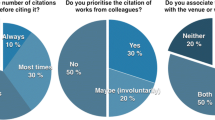Abstract
The notion of core documents and their application is discussed in the context of scientometric networks. An interesting solution of the problem of the arbitrariness of thresholds emerges from the application of Hirsch-type indices to dense networks as are typically observed in local clustering. Examples from several disciplines in the sciences and social sciences illustrate how these core vertices can be determined using this approach, and visualise how core documents are applied to represent the internal structure of the complete network or of parts of it.



Similar content being viewed by others
References
Batagelj, V., & Mrvar, A. (2002). Pajek—analysis and visualization of large networks. Graph Drawing, 2265, 477–478.
Barcza, K., & Telcs, A. (2009). Paretian publication patterns imply Paretian Hirsch index. Scientometrics, 81(2), 513–519.
Burrell, Q. L. (2007). On the h-index, the size of the Hirsch core and Jin’s A-index. Journal of Informetrics, 1(2), 170–177.
Glänzel, W., & Czerwon, H. J. (1996). A new methodological approach to bibliographic coupling and its application to the national, regional and institutional level. Scientometrics, 37(2), 195–221.
Glänzel, W. (2006). On the h-index—A mathematical approach to a new measure of publication activity and citation impact. Scientometrics, 67(2), 315–321.
Glänzel, W., & Thijs, B. (2011a). Using `core documents’ for the representation of clusters and topics. Scientometrics, 88(1), 297–309.
Glänzel, W., Thijs, B. (2011b). Using ‘core documents’ for detecting new emerging topics. In E. Noyons, P Ngulube & J Leta (Eds), Proceedings of ISSI 2011 Conference—13 th International Conference on Scientometrics and Informetrics, Durban, South Africa, 04–07 July 2011, 224–235.
Hirsch, J. E. (2005). An index to quantify an individual’s scientific research output. Proceedings of the National Academy of Sciences of the United States of America, 102(46), 16569–16572.
Jarneving, B. (2007a). Bibliographic coupling and its application to research-front and other core documents. Journal of Informetrics, 1(4), 287–307.
Jarneving, B. (2007b). Complete graphs and bibliographic coupling: A test of the applicability of bibliographic coupling for the identification of cognitive cores on the field level. Journal of Informetrics, 1(4), 338–356.
Korn, A., Schubert, A., & Telcs, A. (2009). Lobby index in networks. Physica A, 388, 2221–2226.
Rousseau, R. (2006). New developments related to the Hirsch index. Science Focus, 1(4), 23–25. (in Chinese).
Schubert, A. (2009). Using the h-index for assessing single publications. Scientometrics, 78(3), 559–565.
Schubert, A., Korn, A., & Telcs, A. (2009). Hirsch-type indices for characterizing networks. Scientometrics, 78(2), 375–382.
Sen, S. K., & Gan, S. K. (1983). A mathematical extension of the idea of bibliographic coupling and its applications. Annals of Library Science and Documentation, 30, 78–82.
Small, H. (1973). Cocitation in scientific literature—new measure of relationship between 2 documents. Journal of the American Society for Information Science, 24(4), 265–269.
Zhang, L., Glänzel, W., & Liang, L. (2009). Tracing the role of individual journals in a cross-citation network based on different indicators. Scientometrics, 81(3), 821–838.
Acknowledgments
The author would like to thank Dr. Bart Thijs (ECOOM, K.U. Leuven) for processing and preparation of the bibliometric data. Methodology has partially been developed in the context of the ERACEP project within the Coordination and Support Actions (CSAs) of the European Research Council (ERC) work programme. The author wishes to acknowledge this support.
Author information
Authors and Affiliations
Corresponding author
Rights and permissions
About this article
Cite this article
Glänzel, W. The role of core documents in bibliometric network analysis and their relation with h-type indices. Scientometrics 93, 113–123 (2012). https://doi.org/10.1007/s11192-012-0639-3
Received:
Published:
Issue Date:
DOI: https://doi.org/10.1007/s11192-012-0639-3




